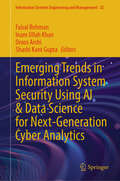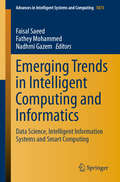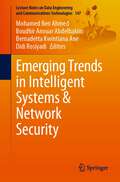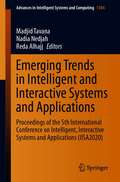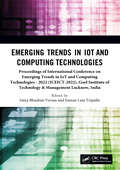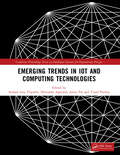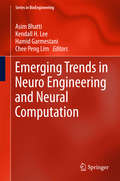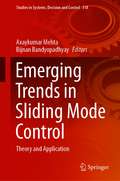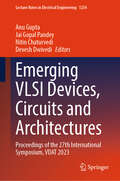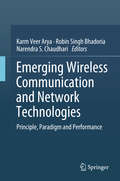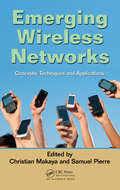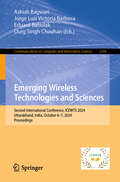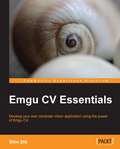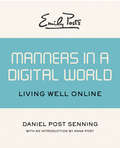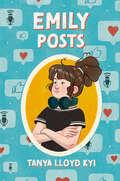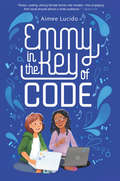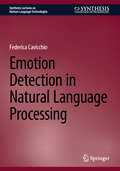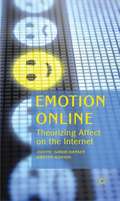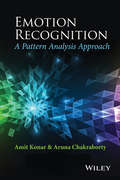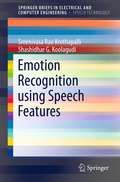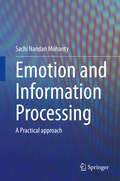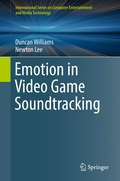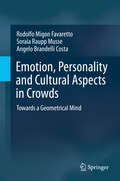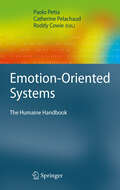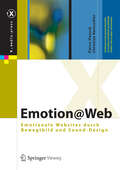- Table View
- List View
Emerging Trends in Information System Security Using AI & Data Science for Next-Generation Cyber Analytics (Information Systems Engineering and Management #32)
by Inam Ullah Khan Shashi Kant Gupta Oroos Arshi Faisal RehmanThis book is a comprehensive exploration into the intersection of cutting-edge technologies and the critical domain of cybersecurity; this book delves deep into the evolving landscape of cyber threats and the imperative for innovative solutions. From establishing the fundamental principles of cyber security to scrutinizing the latest advancements in AI and machine learning, each chapter offers invaluable insights into bolstering defenses against contemporary threats. Readers are guided through a journey that traverses the realms of cyber analytics, threat analysis, and the safeguarding of information systems in an increasingly interconnected world. With chapters dedicated to exploring the role of AI in securing IoT devices, employing supervised and unsupervised learning techniques for threat classification, and harnessing the power of recurrent neural networks for time series analysis, this book presents a holistic view of the evolving cybersecurity landscape. Moreover, it highlights the importance of next-generation defense mechanisms, such as generative adversarial networks (GANs) and federated learning techniques, in combating sophisticated cyber threats while preserving privacy. This book is a comprehensive guide to integrating AI and data science into modern cybersecurity strategies. It covers topics like anomaly detection, behaviour analysis, and threat intelligence, and advocates for proactive risk mitigation using AI and data science. The book provides practical applications, ethical considerations, and customizable frameworks for implementing next-gen cyber defense strategies. It bridges theory with practice, offering real-world case studies, innovative methodologies, and continuous learning resources to equip readers with the knowledge and tools to mitigate cyber threats.
Emerging Trends in Intelligent Computing and Informatics: Data Science, Intelligent Information Systems and Smart Computing (Advances in Intelligent Systems and Computing #1073)
by Faisal Saeed Nadhmi Gazem Fathey MohammedThis book presents the proceedings of the 4th International Conference of Reliable Information and Communication Technology 2019 (IRICT 2019), which was held in Pulai Springs Resort, Johor, Malaysia, on September 22–23, 2019. Featuring 109 papers, the book covers hot topics such as artificial intelligence and soft computing, data science and big data analytics, internet of things (IoT), intelligent communication systems, advances in information security, advances in information systems and software engineering.
Emerging Trends in Intelligent Systems & Network Security (Lecture Notes on Data Engineering and Communications Technologies #147)
by Mohamed Ben Ahmed Bernadetta Kwintiana Ane Boudhir Anouar Abdelhakim Didi RosiyadiThis book covers selected research works presented at the fifth International Conference on Networking, Information Systems and Security (NISS 2022), organized by the Research Center for Data and Information Sciences at the National Research and Innovation Agency (BRIN), Republic of Indonesia, and Moroccan Mediterranean Association of Sciences and Sustainable Development, Morocco, during March 30–31, 2022, hosted in online mode in Bandung, Indonesia. Building on the successful history of the conference series in the recent four years, this book aims to present the paramount role of connecting researchers around the world to disseminate and share new ideas in intelligent information systems, cyber-security, and networking technologies. The 49 chapters presented in this book were carefully reviewed and selected from 115 submissions. They focus on delivering intelligent solutions through leveraging advanced information systems, networking, and security for competitive advantage and cost savings in modern industrial sectors as well as public, business, and education sectors. Authors are eminent academicians, scientists, researchers, and scholars in their respective fields from across the world.
Emerging Trends in Intelligent and Interactive Systems and Applications: Proceedings of the 5th International Conference on Intelligent, Interactive Systems and Applications (IISA2020) (Advances in Intelligent Systems and Computing #1304)
by Madjid Tavana Reda Alhajj Nadia NedjahThis book reports on the proceeding of the 5th International Conference on Intelligent, Interactive Systems and Applications (IISA 2020), held in Shanghai, China, on September 25–27, 2020. The IISA proceedings, with the latest scientific findings, and methods for solving intriguing problems, are a reference for state-of-the-art works on intelligent and interactive systems. This book covers nine interesting and current topics on different systems’ orientations, including Analytical Systems, Database Management Systems, Electronics Systems, Energy Systems, Intelligent Systems, Network Systems, Optimization Systems, and Pattern Recognition Systems and Applications. The chapters included in this book cover significant recent developments in the field, both in terms of theoretical foundations and their practical application. An important characteristic of the works included here is the novelty of the solution approaches to the most interesting applications of intelligent and interactive systems.
Emerging Trends in IoT and Computing Technologies: Proceedings of the International Conference on Emerging Trends in IoT and Computing Technologies (ICEICT-2022), April 22-23, 2022, Lucknow, India
by Suman Lata Tripathi Satya Bhushan VermaThis book includes the proceedings of the International Conference on Emerging Trends in IoT and Computing Technologies (ICEICT-2022) held at Goel Institute of Technology & Management, Lucknow, India.
Emerging Trends in IoT and Computing Technologies: Proceedings of the International Conference on Emerging Trends in IoT and Computing Technologies-2023 (Conference Proceedings Series on Intelligent Systems for Engineering Designs)
by Suman Lata Tripathi Devendra Agarwal Anita Pal Yusuf PerwejSecond International Conference on Emerging Trends in IOT and Computing Technologies (ICEICT – 2023) is organised with a vision to address the various issues to promote the creation of intelligent solution for the future. It is expected that researchers will bring new prospects for collaboration across disciplines and gain ideas facilitating novel concepts. Second International Conference of Emerging Trends in IoT and Computer Technologies (ICEICT-2023) is an inventive event organised in Goel Institute of Technology and Management, Lucknow, India, with motive to make available an open International forum for the researches, academicians, technocrats, scientist, engineers, industrialist and students around the globe to exchange their innovations and share the research outcomes which may lead the young researchers, academicians and industrialist to contribute to the global society. The conference ICEICT- 2023 is being organised at Goel Institute of Technology and Management, Lucknow, Uttar Pradesh, during 12-13 January 2024. It will feature world-class keynote speakers, special sessions, along with the regular/oral paper presentations. The conference welcomes paper submissions from researcher, practitioners, academicians and students will cover numerous tracks in the field of Computer Science and Engineering and associated research areas.
Emerging Trends in Neuro Engineering and Neural Computation
by Hamid Garmestani Asim Bhatti Kendall H. Lee Chee Peng LimThis book focuses on neuro-engineering and neural computing, a multi-disciplinary field of research attracting considerable attention from engineers, neuroscientists, microbiologists and material scientists. It explores a range of topics concerning the design and development of innovative neural and brain interfacing technologies, as well as novel information acquisition and processing algorithms to make sense of the acquired data. The book also highlights emerging trends and advances regarding the applications of neuro-engineering in real-world scenarios, such as neural prostheses, diagnosis of neural degenerative diseases, deep brain stimulation, biosensors, real neural network-inspired artificial neural networks (ANNs) and the predictive modeling of information flows in neuronal networks. The book is broadly divided into three main sections including: current trends in technological developments, neural computation techniques to make sense of the neural behavioral data, and application of these technologies/techniques in the medical domain in the treatment of neural disorders.
Emerging Trends in Sliding Mode Control: Theory and Application (Studies in Systems, Decision and Control #318)
by Axaykumar Mehta Bijnan BandyopadhyayThis book compiles recent developments on sliding mode control theory and its applications. Each chapter presented in the book proposes new dimension in the sliding mode control theory such as higher order sliding mode control, event triggered sliding mode control, networked control, higher order discrete-time sliding mode control and sliding mode control for multi-agent systems. Special emphasis has been given to practical solutions to design involving new types of sliding mode control. This book is a reference guide for graduate students and researchers working in the domain for designing sliding mode controllers. The book is also useful to professional engineers working in the field to design robust controllers for various applications.
Emerging VLSI Devices, Circuits and Architectures: Proceedings of the 27th International Symposium, VDAT 2023 (Lecture Notes in Electrical Engineering #1234)
by Anu Gupta Jai Gopal Pandey Nitin Chaturvedi Devesh DwivediThis book constitutes the proceedings of the 27th International Symposium on VLSI Design and Test, VDAT 2023. The 32 regular papers and 16 short papers presented in this book are carefully reviewed and selected from 220 submissions. They are organized in topical sections as follows: Low-Power Integrated Circuits and Devices; FPGA-Based Design and Embedded Systems; Memory, Computing, and Processor Design; CAD for VLSI; Emerging Integrated Circuits and Systems; VLSI Testing and Security; and System-Level Design.
Emerging Wireless Communication and Network Technologies: Principle, Paradigm and Performance
by Robin Singh Bhadoria Karm Veer Arya Narendra S. ChaudhariThe book covers a wide range of wireless communication and network technologies, and will help readers understand the role of wireless technologies in applications touching on various spheres of human life, e.g. healthcare, agriculture, building smart cities, forecasting and the manufacturing industry.The book begins by discussing advances in wireless communication, including emerging trends and research directions for network technologies. It also highlights the importance of and need to actively develop these technologies. In turn, the book addresses different algorithms and methodologies which could be beneficial in implementing 5G Mobile Communication, Vehicular Ad-hoc Networks (VANET), Reliable Cooperative Networks, Delay Tolerant Networks (DTN) and many more contexts related to advanced communications. It then addresses the prominence of wireless communication in connection with the Internet of Things (IoT), Mobile Opportunistic Networks and Cognitive Radio Networks (CRN). Lastly, it presents the new horizons in architecture and building protocols for Li-Fi (Light-Fidelity) and Wearable Sensor Technology.
Emerging Wireless Networks: Concepts, Techniques and Applications
by Samuel Pierre Christian MakayaAn authoritative collection of research papers and surveys, Emerging Wireless Networks: Concepts, Techniques, and Applications explores recent developments in next-generation wireless networks (NGWNs) and mobile broadband networks technologies, including 4G (LTE, WiMAX), 3G (UMTS, HSPA), WiFi, mobile ad hoc networks, mesh networks, and wireles
Emerging Wireless Technologies and Sciences: Second International Conference, ICEWTS 2024, Uttarakhand, India, October 6–7, 2024, Proceedings (Communications in Computer and Information Science #2399)
by Ashish Bagwari Durg Singh Chauhan Eduard Babulak Jorge Luis Victoria BarbosaThis book constitutes the refereed proceedings of the Second International Conference on Emerging Wireless Technologies and Sciences, ICEWTS 2024, held in Uttarakhand, India, during October 6–7, 2024.The 8 full papers and 4 short papers included in this book were carefully reviewed and selected from 430 submissions. They focus on multidisciplinary framework of communication engineering, wireless sensor networks, electrical engineering, renewable energies, materials science, physics, mathematics, computer, environment, and many more.
Emgu CV Essentials
by Shin ShiThis book provides a practical guide to Emgu CV libraries, with sample code and examples used throughout to explain the concepts clearly. Each chapter deals with a different aspect of the Computer Vision field and the implementation of that topic in Emgu CV.If you are a C# programmer working on computer vision projects, this book is for you. You should have prior experience with C#.
Emily Post's Manners in a Digital World: Living Well Online
by Daniel Post SenningThe great-great-grandson of Emily Post carries on her well-mannered tradition with netiquette rules for social media, online dating, work, and more. For generations of Americans, the Emily Post Institute is the authoritative source on how to behave with confidence and tact. Manners in a Digital World is its up-to-the-minute, straight-talking guide that tackles how we should act when using a digital device or when online. As communication technologies change, our smartphones and tablets become even more essential to our daily lives, and the most polished and appropriate ways to use them often remain unclear. As anyone who has mistakenly forwarded an email knows, there are many pitfalls, too. This essential guide discusses topics such as: · Why you need a healthy digital diet that includes texts, emails, and calls · How to appropriately handle a breakup announcement on social media · What makes for the best—and the worst—online comment · How to maintain privacy and security for online profiles and accounts, essential for everything from banking to online dating · How parents and children can establish digital house rules · The appropriate, low-maintenance ways to separate personal and professional selves onlineEmily Post&’s Manners in a Digital World is for technophiles and technophobes alike—it&’s for anyone who wants to navigate today&’s communication environment with emotional intelligence.
Emily Posts
by Tanya Lloyd KyiMiddle school podcast advice columnist + social media influencer wannabe Emily Laurence takes on the principal at her school to stand up for a climate march, in this fun, school-based drama for ages 10 and up. For fans of Gordon Korman and Susin Nielsen.Emily is the ringleader for her school podcast, Cedarview Speaks — Sponsored by CoastFresh! But her plans for middle-school fame and social media influence are derailed when Amelie joins her eighth-grade class. The new arrival has a seemingly endless supply of confidence and a gift for leading people. Or leading them astray, as far as Emily's concerned.Emily puts her old-fashioned sense of etiquette into practice. Rather than confronting Amelie, she focuses her energy on creating a podcast story about an upcoming climate march. But her story is censored by the school principal. When she protests, Emily gets cut from the podcast crew . . . and Amelie takes her place!Can Emily use her influence to spread the news of the climate march, reclaim her place on the podcast team and expose the flaws of CoastFresh? Can she balance her impeccable manners with twenty-first century activism? And how will she ever manage to work alongside Amelie?With a light touch and plenty of humor, Emily Posts explores issues of social media, influence, corporate sponsorship . . . and the fraught waters of middle-school friendship.
Emmy in the Key of Code
by Aimee LucidoIn this innovative middle grade novel, coding and music take center stage as new girl Emmy tries to find her place in a new school. Perfect for fans of GIRLS WHO CODE series and THE CROSSOVER.In a new city, at a new school, twelve-year-old Emmy has never felt more out of tune. Things start to look up when she takes her first coding class, unexpectedly connecting with the material—and Abigail, a new friend—through a shared language: music. But when Emmy gets bad news about their computer teacher, and finds out Abigail isn’t being entirely honest about their friendship, she feels like her new life is screeching to a halt. Despite these obstacles, Emmy is determined to prove one thing: that, for the first time ever, she isn’t a wrong note, but a musician in the world's most beautiful symphony.
Emotion Detection in Natural Language Processing (Synthesis Lectures on Human Language Technologies)
by Federica CavicchioThis book provides a practical guide on annotating emotions in natural language data and showcases how these annotations can improve Natural Language Processing (NLP) and Natural Language Understanding (NLU) models and applications. The author presents an introduction to emotion as well as the ethical considerations on emotion annotation. State-of-the-art approaches to emotion annotation in NLP and NLU including rule-based, machine learning, and deep learning applications are addressed. Theoretical foundations of emotion and the implication on emotion annotation are discussed along with the current challenges and limitations in emotion annotation. This book is appropriate for researchers and practitioners in the field of NLP and NLU and anyone interested in the intersection of natural language and emotion.
Emotion Online
by Joanne Garde-HansenEmotion Online: Theorizing Affect on the Internet takes stock of where we are emotionally with regards to the Internet in social and cultural terms. Online users are switching between personal, national, international and global modes of being and feeling that shape private and public experiences. Drawing upon the well-established discipline of media studies, the book travels theoretically through, across, in and between examples of traditional media as they merge and emerge online. Garde-Hansen and Gorton explore how we feel about, and how we feel in, our online media ecology in the context of global media platforms.
Emotion Recognition
by Aruna Chakraborty Amit KonarOffers both foundations and advances on emotion recognition in a single volumeProvides a thorough and insightful introduction to the subject by utilizing computational tools of diverse domainsInspires young researchers to prepare themselves for their own researchDemonstrates direction of future research through new technologies, such as Microsoft Kinect, EEG systems etc.
Emotion Recognition using Speech Features
by K. Sreenivasa Rao Shashidhar G. Koolagudi"Emotion Recognition Using Speech Features" provides coverage of emotion-specific features present in speech. The author also discusses suitable models for capturing emotion-specific information for distinguishing different emotions. The content of this book is important for designing and developing natural and sophisticated speech systems. In this Brief, Drs. Rao and Koolagudi lead a discussion of how emotion-specific information is embedded in speech and how to acquire emotion-specific knowledge using appropriate statistical models. Additionally, the authors provide information about exploiting multiple evidences derived from various features and models. The acquired emotion-specific knowledge is useful for synthesizing emotions. Features includes discussion of: * Global and local prosodic features at syllable, word and phrase levels, helpful for capturing emotion-discriminative information; * Exploiting complementary evidences obtained from excitation sources, vocal tract systems and prosodic features in order to enhance the emotion recognition performance; * Proposed multi-stage and hybrid models for improving the emotion recognition performance. This brief is for researchers working in areas related to speech-based products such as mobile phone manufacturing companies, automobile companies, and entertainment products as well as researchers involved in basic and applied speech processing research.
Emotion and Information Processing: A Practical approach
by Sachi Nandan MohantyThis book consists of thirteen chapters covering many facts like psycho-social intervention on emotional disorders in individuals, impact of emotion and cognition on blended theory, theory and implication of information processing, effects of emotional self esteem in women, emotional dimension of women in workplace, effects of mental thinking in different age groups irrespective of the gender, negative emotions and its effect on information processing, role of emotions in education and lastly emotional analysis in multi perspective domain adopting machine learning approach. Most of the chapters having experimental studies, with each experiment having different constructs as well as different samples for each data collection. Most of the studies measure information processing within altered mood states, such as depression, anxiety, or positive emotional states, with mental ability tasks being conducted in addition to the experiments of quasi-experimental design.
Emotion in Video Game Soundtracking
by Newton Lee Duncan WilliamsThis book presents an overview of the emerging field of emotion in videogame soundtracking. The emotional impact of music has been well-documented, particularly when used to enhance the impact of a multimodal experience, such as combining images with audio as found in the videogames industry. Soundtracking videogames presents a unique challenge compared to traditional composition (for example film music) in that the narrative of gameplay is non-linear – Player dependent actions can change the narrative and thus the emotional characteristics required in the soundtrack. Historical approaches to emotion measurement, and the musical feature mapping and music selection that might be used in video game soundtracking are outlined, before a series of cutting edge examples are given. These examples include algorithmic composition techniques, automated emotion matching from biosensors, motion capture techniques, emotionally-targeted speech synthesis and signal processing, and automated repurposing of existing music (for example from a players own library). The book concludes with some possibilities for the future.
Emotion, Personality and Cultural Aspects in Crowds: Towards a Geometrical Mind
by Rodolfo Migon Favaretto Soraia Raupp Musse Angelo Brandelli CostaThis practically-focused book presents a computational model for detection and analysis of pedestrian features in crowds from video sequences.The study of human behavior is a subject of great scientific interest and probably an inexhaustible source of research. The analysis of pedestrians and groups in crowds is relevant in several areas of application, such as security, entertainment, environmental and public spaces planning and social sciences. Cultural and personality aspects are attributes that can influence personal behavior and affect the group in which individuals belong.In this sense, we consider different ways of characterizing individuals and groups in crowds with respect to their relationship with the geometrical space and time. We discuss and describe an approach to extract and analyse, from the Computer Science point of view, emotions, personalities and cultural aspects from crowds and groups of pedestrians, using Computer Vision techniques.Extracting characteristics from real pedestrians and crowds, benefits other areas, such as: architecture and design (planning spaces to maximize pedestrian and group-environment fit); security and surveillance (design of evacuation plans considering characteristics of the crowds and detection of abnormal events); entertainment (more realistic crowds in movies and games reproducing characteristics from real pedestrians and crowds); social sciences (understanding of human behavior), among others.A big challenge in this area of research is the comparison with real life data. In this book, we successfully compared the results of the proposed approach with Psychology literature, where several studies aimed to analysis human behavior.
Emotion-Oriented Systems
by Catherine Pelachaud Paolo Petta Roddy CowieEmotion pervades human life in general, and human communication in particular, and this sets information technology a challenge. Traditionally, IT has focused on allowing people to accomplish practical tasks efficiently, setting emotion to one side. That was acceptable when technology was a small part of life, but as technology and life become increasingly interwoven we can no longer ask people to suspend their emotional nature and habits when they interact with technology. The European Commission funded a series of related research projects on emotion and computing, culminating in the HUMAINE project which brought together leading academic researchers from the many related disciplines. This book grew out of that project, and its chapters are arranged according to its working areas: theories and models; signals to signs; data and databases; emotion in interaction; emotion in cognition and action; persuasion and communication; usability; and ethics and good practice. The fundamental aim of the book is to offer researchers an overview of the related areas, sufficient for them to do credible work on affective or emotion-oriented computing. The book serves as an academically sound introduction to the range of disciplines involved - technical, empirical and conceptual - and will be of value to researchers in the areas of artificial intelligence, psychology, cognition and user--machine interaction.
Emotion@Web
by Christian Rentschler Pierre HanschBranchenübergreifend ist eine Verlagerung von den klassischen Medien hin zur digitalen Markenführung zu beobachten. Ziel ist es, effektiver, messbarer und emotionaler zu werben. Das Buch behandelt erstmalig alle Aspekte eines emotionalisierten Webauftritts - von der Konzeption bis zur Umsetzung. Dabei setzten sich die Autoren auf theoretischer wie praktischer Ebene mit auditiven und visuellen Fragen auseinander. Der Band ist zugleich Leitfaden und Nachschlagewerk, eine begleitende Website bietet weiterführende Informationen und Beispiele.
